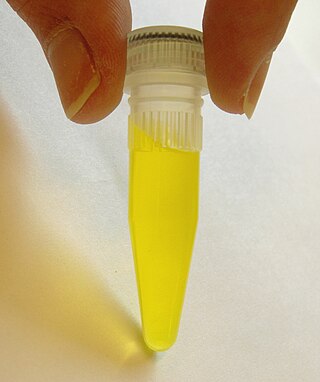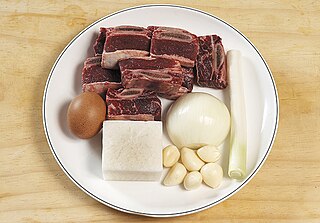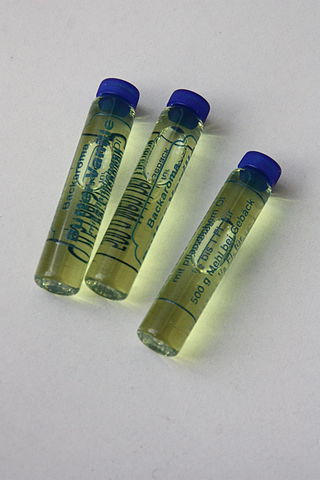Related Research Articles

A flavoring, also known as flavor or flavorant, is a food additive used to improve the taste or smell of food. It changes the perceptual impression of food as determined primarily by the chemoreceptors of the gustatory and olfactory systems. Along with additives, other components like sugars determine the taste of food.

Food additives are substances added to food to preserve flavor or enhance taste, appearance, or other sensory qualities. Some additives have been used for centuries as part of an effort to preserve food, for example vinegar (pickling), salt (salting), smoke (smoking), sugar (crystallization), etc. This allows for longer-lasting foods such as bacon, sweets or wines. With the advent of ultra-processed foods in the second half of the twentieth century, many additives have been introduced, of both natural and artificial origin. Food additives also include substances that may be introduced to food indirectly in the manufacturing process, through packaging, or during storage or transport.
A preservative is a substance or a chemical that is added to products such as food products, beverages, pharmaceutical drugs, paints, biological samples, cosmetics, wood, and many other products to prevent decomposition by microbial growth or by undesirable chemical changes. In general, preservation is implemented in two modes, chemical and physical. Chemical preservation entails adding chemical compounds to the product. Physical preservation entails processes such as refrigeration or drying. Preservative food additives reduce the risk of foodborne infections, decrease microbial spoilage, and preserve fresh attributes and nutritional quality. Some physical techniques for food preservation include dehydration, UV-C radiation, freeze-drying, and refrigeration. Chemical preservation and physical preservation techniques are sometimes combined.

Yeast extracts consist of the cell contents of yeast without the cell walls; they are used as food additives or flavorings, or as nutrients for bacterial culture media. They are often used to create savoury flavors and umami taste sensations and can be found in a large variety of packaged foods including frozen meals, crackers, snack foods, gravy, stock and more. They are rich in B vitamins. Yeast extracts and fermented foods contain glutamic acid, an amino acid which adds an umami flavor. Glutamic acid is found in meat, cheese, fungi and vegetables—such as broccoli and tomatoes. A number of other substances found in yeast extract provide aromas, some meat-like, when allowed to react under heat.

E numbers, short for Europe numbers, are codes for substances used as food additives, including those found naturally in many foods, such as vitamin C, for use within the European Union (EU) and European Free Trade Association (EFTA). Commonly found on food labels, their safety assessment and approval are the responsibility of the European Food Safety Authority (EFSA). The fact that an additive has an E number implies that its use was at one time permitted in products for sale in the European Single Market; some of these additives are no longer allowed today.

Food coloring, color additive or colorant is any dye, pigment, or substance that imparts color when it is added to food or beverages. Colorants can be supplied as liquids, powders, gels, or pastes. Food coloring is commonly used in commercial products and in domestic cooking.

Squash, is a non-alcoholic beverage with syrup used in beverage making. It is usually fruit-flavoured, made from fruit juice, water, and sugar or a sugar substitute. Modern squashes may also contain food colouring and additional flavouring. Some traditional squashes contain herbal extracts, most notably elderflower and ginger.

Kraft Dinner in Canada, Kraft Mac & Cheese in the United States, Australia and New Zealand, Mac and Cheese in the United Kingdom and internationally, is a nonperishable, packaged macaroni and cheese product. It is made by Kraft Foods Group and traditionally cardboard-boxed with dried macaroni pasta and a packet of processed cheese powder. It was introduced under the Kraft Dinner name simultaneously in both Canada and the U.S. in 1937. The brand is particularly popular with Canadians, who consume 55% more boxes per capita than Americans.

Neohesperidin dihydrochalcone, sometimes abbreviated to neohesperidin DC or simply NHDC, is an artificial sweetener derived from citrus.

Food processing is the transformation of agricultural products into food, or of one form of food into other forms. Food processing takes many forms, from grinding grain into raw flour, home cooking, and complex industrial methods used in the making of convenience foods. Some food processing methods play important roles in reducing food waste and improving food preservation, thus reducing the total environmental impact of agriculture and improving food security.

Salty liquorice, salmiak liquorice or salmiac liquorice, is a variety of liquorice flavoured with salmiak salt, and is a common confection found in the Nordic countries, Benelux, and northern Germany. Salmiak salt gives salty liquorice an astringent, salty taste, akin to that of tannins—a characteristic of red wines, which adds bitterness and astringency to the flavour. Consuming salmiak liquorice can stimulate either a savoury or non-savoury palate and response. Anise oil can also be an additional main ingredient in salty liquorice. Extra-salty liquorice is additionally coated with salmiak salt or salmiak powder, or sometimes table salt.

Liquid smoke is a water-soluble yellow to red liquid used as a flavoring as a substitute for cooking with wood smoke while retaining a similar flavor. It can be used to flavor any meat or vegetable. It is available as pure condensed smoke from various types of wood, and as derivative formulas containing additives.

In a general sense, an ingredient is a substance which forms part of a mixture. In cooking, recipes specify which ingredients are used to prepare a dish. Many commercial products contain secret ingredients purported to make them better than competing products. In the pharmaceutical industry, an active ingredient is the ingredient in a formulation which invokes biological activity.
The law in the United Kingdom on food information and labelling is multifaceted and is spread over many reforms and parliamentary acts. UK law is based on the relevant European Union rules, chiefly Regulation (EU) 1169/2011, which is implemented in the UK in the Food Information Regulations 2014, the Food Information (Wales) Regulations 2014, the Food Information (Scotland) Regulations 2014 and the Food Information Regulations 2014. Regulations apply to the labelling of goods pre-packaged for sale and to the provision of information regarding non-prepacked (loose) foods.

Natural food and all-natural food are terms in food labeling and marketing with several definitions, often implying foods that are not manufactured by processing. In some countries like the United Kingdom, the term "natural" is defined and regulated; in others, such as the United States, the term natural is not enforced for food labels, although there is USDA regulation of organic labeling.

Creamola Foam was a soft drink produced in the form of effervescent crystals that were mixed with water. It was manufactured in Glasgow and sold in the UK from the 1950s, until Nestlé ended production in October 1998.
Robertet Group is a French fragrance and flavor manufacturer that specializes in natural raw materials founded in 1850. Robertet is a member of the European Flavour Association. In 2021, Robertet ranked 12th on FoodTalks' Global Top 50 Food Flavours and Fragrances Companies list.

Artificial butter flavoring is a flavoring used to give a food the taste and smell of butter. It may contain diacetyl, acetylpropionyl, or acetoin, three natural compounds in butter that contribute to its characteristic taste and smell. Manufacturers of margarines or similar oil-based products typically add it to make the final product butter-flavored, because it would otherwise be relatively tasteless.
Federal responsibility for Canadian food labelling requirements is shared between two departments, Health Canada and the Canadian Food Inspection Agency (CFIA).
Ch'ang Ming is a series of dietary and health recommendations based on Taoist philosophy. It was first introduced to the West by Chan Kam Lee, a Taoist teacher and Chinese herbal medicine practitioner who came to London in 1930 from Shandong Province in China. He took the Taoist principles of Traditional Chinese Medicine and adapted them to Western foods and eating habits.
References
- ↑ Clean Labels. Lebensmittelverband (Archived July 2019)(in German)
- ↑ How the EU has left “clean labelling” open to national initiatives. Lexology, 4 Nov 2019
- ↑ Summary record of the SCOFCAH, point 4. Standing Committee On the Food Chain and Animal Health, 14 Dec 2006 (archived).
"It has been reported that some manufacturers of meat products were using standardised spinach extracts containing high levels of nitrates. Furthermore such products are labelled to imply that they contain no added preservatives. It has therefore been questioned whether such use should be considered as that of a food additive as it may exert a preservative and/or colour fixing effect." - ↑ „Ohne Zusatzstoffe“ – trotzdem gefärbt, aromatisiert und im Geschmack verstärkt. Verbraucherzentrale (archived Sep 2011, in German)